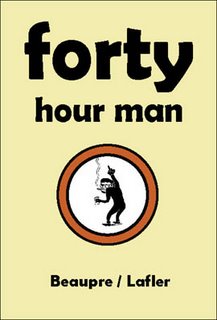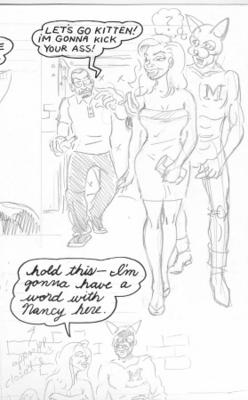
Why would an intelligent human being embark on a "career" in art comics??? I try to answer this question with an essay that appeared in the back of Scalawag, my latest graphic novel. I also had the chance to read this piece over the airwaves recently in an interview with Bill Dodge on Radio KBOO 90.7 here in Portland, OR.
My brother John and I read and collected mountains of comics starting with Archie, Harvey, and Disney (Carl Barks!) comics, and moved onto Marvel when I was ten. After several years of obsessing over the amazing chops of Jack Kirby, I got published at age 16, illustrating faux Barry Smith barbarian stories for cheesy fanzines. There were scads of these sleazy “fanzines” in those days, often mimeographed, that would publish my output of aforementioned barbarian stuff, along with attempts at superhero strips and adaptations of Greek Myths. Somewhere in there, Eisner and Crumb got thrown into the mix, teaching me how it is done with regard to A) storytelling and B) sex.
Although I drew comics through high school, my focus turned to running the mile on the track team, and it wasn’t until I was in college that I really dug in. I started attending UMASS Amherst in the fall of ’75, and it wasn’t lost on me that the Massachusetts Daily Collegian had slots for four or five daily comic strips by students. WOW! What an opportunity for a green kid full of ambition!
At the start of my second semester, I landed a strip there and continued daily publication until I graduated in December of 1979. I experienced such arcane pleasures as strolling campus on Halloween, tripping my nuts off, seeing numerous kids dressed as my characters Benb & Gerald. What an education, and what an ego I developed after having an audience of 20,000 daily for four years… yup, I was a typical know-it-all college kid. I was the complete holy fool during the run of my strip, Aluminum Foil. I was full of the hedonistic yet metaphysical spirit of the times. It didn’t hurt that at the age of nineteen I had the classic coming of age experience: Being turned inside out on psylocibyn mushrooms. The Catholicism of my youth fell away, replaced by a certainty that physical reality is but the tip of a very large iceberg, and that death (seemingly included in the mushroom experience) was but a transition to greater awareness. The singular vision of that day pretty much informs everything I’ve done since. Oddly, subsequent LSD and mushroom experiences never again punched me through the threshold to the realm of the completely other.
Several months after graduating, I caught the publishing bug and put out Benb & Gerald, a collection of my college strips. Publishing seemed a viable business! I sold the run of 500 books over several months, turning a modest profit.
Wanderlust, love and the lingering dream of becoming a decent runner found me relocating to Eugene, Oregon. By the spring of ’81, I began publishing my work in earnest with a one shot comic entitled Mean Cat, which garnered positive attention in the pages of The Comics Journal and The Comics Buyers Guide. I worked out my chops over a 3 issue run of my next title, Guts. Issue #3 was a landmark for me, as I introduced my Dog Boy character while getting picked up for distribution by Last Gasp and Capital City.
Dog Boy was a wholly improvised comic. I would sit down to draw, divest myself of any assumptions about the nature of reality, and trust to the muse to sing through me. In truth, the lead character was a stand in for me, a sort of zen terrorist rampaging through a post punk landscape on blotter acid and beer.
It was a thrilling time in comics. A network of seven to nine comic book distributors had sprung up over the preceding several years, and they were willing to try new titles.
Sure, a lot of dreck was published; faux mainstream superhero universes sprang up by the dozens, only to disappear just as quickly. But there was cool shit too, Love & Rockets had appeared and was being frantically hyped by Fantagraphics. Crumb showed signs of life for the first time in years with Weirdo, publishing the sultry work of Dori Seda, and Raw appeared from the slick confines of New York. R.L. Crabb had begun to publish some fine work, and the first intense wave of mini comics was underway with talents like J.R. Williams and Steve Willis honing their chops.
I sat down in the summer of ’82 to draw the first issue of Dog Boy. Pencilling and lettering ten pages that first day, I was a man on a mission that would sustain me for years. Dog Boy #1 (special shoe issue) appeared in March of ’83, the first comic book I published under the Cat-Head Comics imprint. Working hard through the next couple years, I published seven issues and built a modest but loyal following. By 1986 (soon after relocating to the Bay Area), I managed to convince Fantagraphics to take a chance on Dog Boy. We published ten issues together as the so called “black & whites” market fluctuated wildly. Dog Boy #1, volume 2, shipped 10,500 copies and suddenly I was actually making a living creating comics, just in time for my 30th birthday! The good men of Fantagraphics pumped out Dog Boy’s for me at an alarming pace, but sad to say by issue ten sales had dipped below 2000 and the Dog was cut.
In retrospect this was appropriate, the arc of inspiration for the series had run it’s course. The freewheeling, beer guzzling, acid dropping persona that had worked so well for me for years became rather an albatross by the time I hit 31. I had become an egotistical lout with no money and a drinking problem!
After floundering for a year or two with an ill-advised title, Femme Noire (great drawings but weak writing), I hooked up with longtime friend Stephen Beaupre and we began publishing together under the Cat-Head Comics imprint. At the dawn of the Nineties, Weirdo and Raw had ended, and we figured it was time for an edgy new comics anthology. We launched Buzzard, inviting such standouts as Joe Sacco, Julie Doucet, Mary Fleener, Mario Hernandez, and Lloyd Dangle to contribute. The first issue was a hit artistically, but the market was weak, especially for anthologies, and it sold a only bit more than 2000 copies. Undaunted, Beaupre and I soldiered on with Buzzard, publishing 20 issues between 1990 and 1998. We featured the work of many great talents known and unknown, from Jeff Roysdon to Mats Stromberg and Phoebe Gloeckner. Even Adriane Tomine and James Kochalka managed to find their way into the pages of Buzzard.
Each issue saw me contribute a short piece of my own work (including some new Dog Boy material), but the real fun for Beaupre and I was our collaboration on his Forty Hour Man. Written by Mr. Beaupre, it’s the saga of his wage slavery from teenage years to the present. Since we met as 17 year old dishwashers at the Rustler Steak House, Stephen Beaupre and I have been friends on an almost telepathic level. I was in the zone with Forty Hour Man, interpreting his narrative into a Will Elder inspired laugh fest, four pages at a time starting in Buzzard #8 and running to issue #20. The Forty Hour Man collection will appear in the summer of 2006, the first book on my new Manx Media imprint.
Meanwhile, also in Buzzard #8, I published 9 pages of my new strip, Bughouse. I was called to arms by the avatars of Bop—Miles, Bird, Sonny Rollins and Ornette Coleman—
and spurred on by visual mavericks like director David Cronenberg (The Fly, Naked Lunch). Thus inspired, I set out to create my own indigo toned, insect-noir world.
The idea of Bughouse rattled about in my head for a while. I wanted to address the nature of addiction in artists; my own slavery to beer (of all drugs), and of so many great musicians to heroin. I wanted to draw and write my way to healing my wounds and make myself whole (and it worked!). Just as important, I wanted to convey my delight in live music, the more raw and impassioned the better. I wanted to create a visual iconography to put across this gestalt of concerns.
Bughouse enjoyed a six issue run and two graphic novels as a Cat-Head Comic. And now, here is Scalawag, the third volume of Bughouse from Top Shelf Productions. With this volume, Top Shelf has all existing Bughouse material in print.
And now, for me, it’s back to the drawing board!
Steve Lafler
Portland Oregon
manxmedia@msn.com








